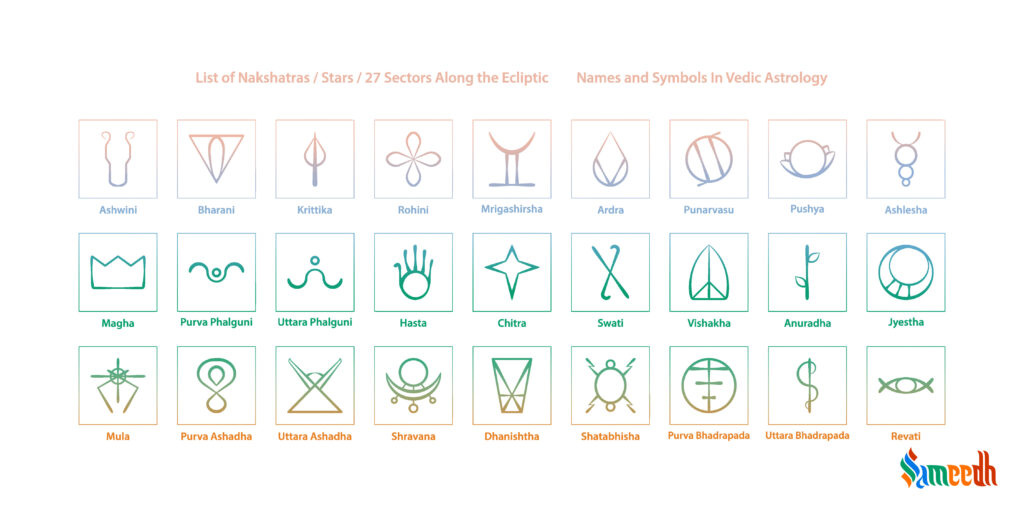The meaning and significance of moon positioning to indicate horoscopes in Hinduism

Nakshatra is a combination of the words Naksha and Tara, meaning Map and Star respectively. It also translates to sky and region. Nakshatra is otherwise known as the lunar mansion, an epileptic through which the moon orbits. According to Hinduism, Nakshatra is used to chart the constellations and alignment of the moon and stars for astrological predictions. Nakshatra has its roots in Vedic Astrology, religious texts.
Although Nakshatra too is used for horoscopes like Zodiac signs, the latter relies on the solar calendar. For determining Zodiacs, the celestial sky is considered as a circle and is divided into 12 parts, each with a 30° angle. As there are 27 Nakshatras, the sky is split into 27 segments, each with an angle of 13.20°, the remaining portion is left for the 28th Nakshatra, Abhijit, which isn’t utilised often. Each of these areas are 13 degrees and 20 minute long. Through the course of a month, the moon passes through all these constellations.
Nakshatra in Hinduism
Lord Brahma, the creator of the Universe, had a son named Daksha. King Daksha had 27 daughters and Chandra, the moon god, wanted to marry Rohini. But upon the King’s request, he married all his daughters resulting in 27 Nakshatras. Even after marriage, Chandra showered his love only on Rohini which angered her sisters. This made King Daksha curse Chandra to shrink. Other deities had to convince Daksha to revoke his curse but it was not possible. So a way around was found by ordering the moon to spend equal time with all 27 daughters. This is what makes the moon circle around the orbit through a month resulting in a full moon, Purnima, and a no moon, Amavasya, days.
With the exact time of birth, Janma, the positioning of the constellation and moon is noted down. Depending on which Nakshatra the moon was in during that phase, an entire horoscope predicting the life of a person is chalked. This is a detailed analysis of the person’s traits, personality type, academic and career performance, relationships, acquisition of money, physical and mental wellness.
Every Nakshatra is ruled by a planet of the solar system. The Nakshatras further have a sign and represent various objects or animal body parts. It is also used to indicate Dasha or phases of planets which influence various factors of life for a set number of months or years. Vimshottari Dasha is a 120 years long cycle of birth of Nakshatra and positioning of planets.
27 Nakshatras
These are broadly divided into three categories; Deva – god or divine, Manush or Nara – Human or Man and Rakshas – demon. Each of them represents a particular symbol.
Ashwini – Horse’s head
Bharani – Yoni, female reproductive organ or inverted triangle
Krittika – Razor, Knife or Spear
Rohini – Chariot
Mrigashirsha – Deer’s head
Ardra – Drop of tear
Punarvasu – Bow and arrow
Pushya – Lotus or rose flower, circle
Ashlesha – Coiled snake
Magha – Royal throne
Purva Phalguni – Front legs of hammock, bed of canvas
Uttara Phalguni – Four legs of hammock
Hasta – Hand
Chitra – Pearl
Swati – Coral, shoot of plant
Vishakha – Potter’s wheel
Anuradha – Lotus
Jyestha – Umbrella, earrings
Mool – Lion’s tail
Purva Asadha – Elephant tusk, basket
Uttara Asadha – Elephant tusk, bed plank
Shravan – Arrows, trident, three footprints
Dhanishtha Pravesh – Drum
Shatabhisha – Empty circle
Purva Bhadrapada – Sword
Uttar Bhadrapada – Twins, two heads, back legs of bed
Revathi – A pair of fish